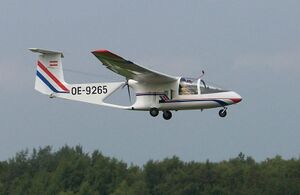Engineering:Brditschka HB-3
| HB-3, HB-21, and HB-23 | |
|---|---|

| |
| Brditschka HB-23 | |
| Role | Motorglider |
| Manufacturer | HB-Flugtechnik |
| Designer | Heino Brditschka |
| First flight | 23 June 1971[1] |
The Brditschka HB-3, HB-21 and HB-23 are a family of motor gliders of unorthodox configuration developed in Austria in the early 1970s.
Design and development
The unusual design was based on work done by Fritz Raab in Germany in the 1960s. The pilot and passengers sit in a fuselage pod with the engine and propeller behind them. The pod also carries the fixed tricycle undercarriage and the high cantilever wing. The tail is carried on a pair of booms that emerge from the top and bottom of the fuselage pod, the upper of which passes through the propeller hub. The HB-21 has a conventional tail and has two seats in tandem accessed by a sidewards-hinged canopy, while the HB-23 has a T-tail and side-by-side seating accessed via gull-wing doors in the canopy.
The Militky MB-E1 was a modified HB-3 with an 8-10 kW (11-13 hp) Bosch KM77 electric motor. It was the first full-sized, manned aircraft to be solely electrically powered. Flights of 12 minutes duration at up to an altitude of 380 m (1,247 ft) were just within the Ni-Cd battery's capacity. Its first flight was on 23 October 1973.[2]
Variants
- Brditschka HB-3
- Single seat powered sailplane, powered by 31 kW (42 hp) Rotax 642 engine, 12.00 m (39 ft 4 in) wingspan.[1]
- HB-Flugtechnik HB 21
- Tandem two-seat derivative of HB-3 with longer span (16.24 m (53 ft 3 in)) wings.[3]
- HB-Flugtechnik HB 21/2400
- HB-Flugtechnik HB 21/2400 B
- HB-Flugtechnik HB 21/2400 V1
- HB-Flugtechnik HB 21/2400 V2
- HB-Flugtechnik HB 23/2400
- HB-Flugtechnik HB 23/2400 SP
- HB-Flugtechnik HB 23/2400 Scanliner
- Observation version of HB-23 with bubble canopy and provision to carry FLIR or LLTV pods under the wings.[4]
- HB-Flugtechnik HB 23/2400 V2
- Militky MB-E1
- electrically powered version.[2]
Specifications (HB-23/2400 Hobbyliner)
Data from Jane's All The World's Aircraft 1990[4]
General characteristics
- Crew: 1
- Capacity: 1 passenger
- Length: 8.00 m (26 ft 3 in)
- Wingspan: 16.40 m (53 ft 10 in)
- Height: 2.45 m (8 ft 0 in)
- Wing area: 19.07 m2 (205.3 sq ft)
- Aspect ratio: 14.1:1
- Airfoil: Wortmann FX-61-184 at root, FX-60-126 at tip
- Empty weight: 560 kg (1,235 lb)
- Max takeoff weight: 760 kg (1,676 lb)
- Fuel capacity: 76 L (17 imp gal; 20 US gal)
- Powerplant: 1 × Volkswagen air-cooled 4-cylinder engine, 73 kW (98 hp)
Performance
- Cruise speed: 180 km/h (110 mph, 97 kn) (max cruise)
- Stall speed: 80 km/h (50 mph, 43 kn) (powered)
- Never exceed speed: 200 km/h (120 mph, 110 kn)
- Range: 800 km (500 mi, 430 nmi)
- Endurance: 6 hours
- Service ceiling: 5,000 m (16,000 ft)
- Maximum glide ratio: 22:1
- Rate of climb: 3.80 m/s (748 ft/min)
- Rate of sink: 1.20 m/s (236 ft/min)
- Takeoff run to 15 m (50 ft): 160 m (525 ft)
See also
Related development
Aircraft of comparable role, configuration and era
References
- Coates, Andrew (1980). Jane's World Sailplanes & Motor Gliders new edition. London: Jane's. ISBN 0-7106-0017-8.
- Lambert, Mark (1990). Jane's All The World's Aircraft 1990–91. Coulsdon, UK: Jane's Defence Data. ISBN 0-7106-0908-6.
- Taylor, John W R (1974). Jane's All the World's Aircraft 1974-75. London: Jane's Yearbooks. ISBN 0-354-00502-2.
- Taylor, John W. R. (1976). Jane's All The World's Aircraft 1976–77. London: Jane's Yearbooks. ISBN 0-354-00538-3.
- Taylor, Michael J. H. (1989). Jane's Encyclopedia of Aviation. London: Studio Editions. pp. 195.
- Simpson, R. W. (1995). Airlife's General Aviation. Shrewsbury: Airlife Publishing. pp. 87–88.
External links
 |

